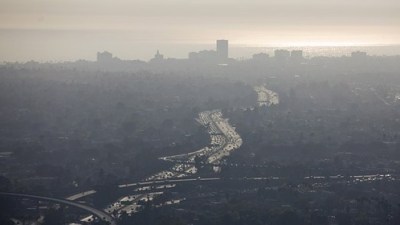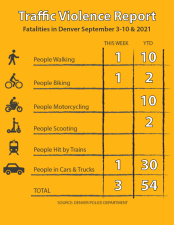Hancock’s Budget Fails to Deliver on His Vision Zero Promises

“The truth about a city’s aspirations isn’t found in its vision,” says former Vancouver planning chief Brent Toderian. “It’s found in its budget.”
With the release of Mayor Michael Hancock’s 2017 budget proposal, you can see the truth about his promise to eliminate traffic deaths — so far, it’s mostly hot air.

In February, Hancock said he was committed to ending fatalities on Denver streets. But the budget he put out yesterday makes no serious attempt to accelerate the redesign of city streets for safe walking, biking, and driving.
Hancock is not proposing any increase in the allocation to bike lanes, or in the amount of bike lanes that will be built. For sidewalks, the $1.9 billion budget proposal sets aside all of $2.5 million. There’s also money to redesign and build “up to 10” safer intersections for pedestrians and bicyclists, as well as for ongoing work to make East Colfax Avenue better for bus riders and Brighton Boulevard better for bicyclists, pedestrians, and transit riders.
It’s a paltry amount of good stuff for a city that is supposedly committed to transforming its streets so people can safely walk and bike.
This year, Hancock has started up several promising initiatives to enhance Denver streets and neighborhoods. He committed to the Vision Zero goal of ending traffic deaths and embarked on a set of plans intended to improve transit, walking, and land use citywide. But it takes more than plans to shape the future of a city.
Budgets are the real test of the mayor’s priorities. And in Hancock’s budget, not much has changed.
Here are the major takeaways about streets from the mayor’s proposal.
Denver Moves, the city’s bike plan, receives no funding increase.
Last year the city budget dedicated $2.2 million to implement the city’s bike plan. This year, after committing to Vision Zero, Hancock dedicated — drum roll, please — $2.2 million to the city’s bike plan.
The budget does include a separate $500,000 line item for bike lane maintenance.
What is clear is that Hancock does not intend to accelerate the implementation of bike lanes. The budget promises two more miles of protected bike lanes in 2017, which will more or less match 2016’s output. Public Works will also stripe 10 miles of unprotected bike lanes next year, and finish three miles of “neighborhood bikeways” — routes designed to prioritize people on bikes by calming car traffic.
The 15 miles of total bike network expansion is the same rate of growth as this year, and will not increase the share of residents who live near a low-stress bikeway.
Unlike last year, Denver sidewalks have their own line item.
The city has set aside some funds to repair and construct sidewalks adjacent to its lots, just like private property owners are required to do. Hancock reserved $2.5 million for sidewalks next to city property like libraries and parks (and, yes, golf courses).
While this will be an improvement over 2016, it’s still just a drop in the bucket compared to the $475 million needed for a complete sidewalk network.
Hancock dedicates $700,000 for “Vision Zero” projects.
Separate from bike lanes and sidewalks, the budget singles out three line items under the “Vision Zero” banner: About $93,000 for a new city planner “to support the Vision Zero program,” $200,000 for a Vision Zero public relations campaign, and $400,000 for “multimodal safety improvements.”
It’s very reminiscent of the 2016 budget, which allocated about $750,00 for a public relations campaign, strategy development, and some street fixes. Here we are a year later and the city has not finished its strategy for eliminating traffic deaths or produced its PR campaign.
Strangely, the budget document, which is supposed to be about the allocation of resources, lays out goals for traffic fatalities and serious injuries next year. The Hancock administration is aiming (for lack of a better word) for 52 traffic deaths (three fewer than its projection for 2016), 388 pedestrian “accidents” (20 fewer), and 300 bike “accidents” (15 fewer).
Hancock aims to redesign “up to 10” intersections.
The budget lists three of these 10 potential locations by name — the 47th and York crossing over the railroad tracks, and two Colfax intersections next to the under-construction Civic Center Station (at Broadway and at Lincoln). Those improvements will cost about $2.1 million.
The budget does not list other intersections by name, likely because Public Works is still evaluating which intersections to improve based on new design and engineering guidelines.
Other allocations for street redesigns.
Some major projects in the works will get planning and/or construction funds in the 2017 budget. Brighton Boulevard’s makeover will continue next year with $2.5 million dedicated for construction. Hancock allocated $2 million in “preliminary engineering” funds for bus lanes on East Colfax, which city transportation officials generously call “bus rapid transit.”
Here are some other notable transit, walking, and biking items from Hancock’s budget:
- $3 million for “Smart Cities Infrastructure.” These projects will be informed by the city’s rejected grant application to U.S. DOT, which centered on technology enabling communication between vehicles, street infrastructure, and people.
- $750,000 for “ped/transit facilities” informed by the Denveright planning initiatives.
- $470,000 toward transit and bicycle improvements to South Broadway.
- $300,000 for new bus stops in Globeville, Elyria, and Swansea.
- $300,000 for a “multi-modal” study of the Hampden Boulevard corridor.
- $105,000 for tech to detect bikes and cars at intersections.
An earlier version of this article stated that Denver’s 2016 budget included $1.2 million for Vision Zero. It actually only allocated $750,000. The error was due to inconsistent numbers in the budget document.


